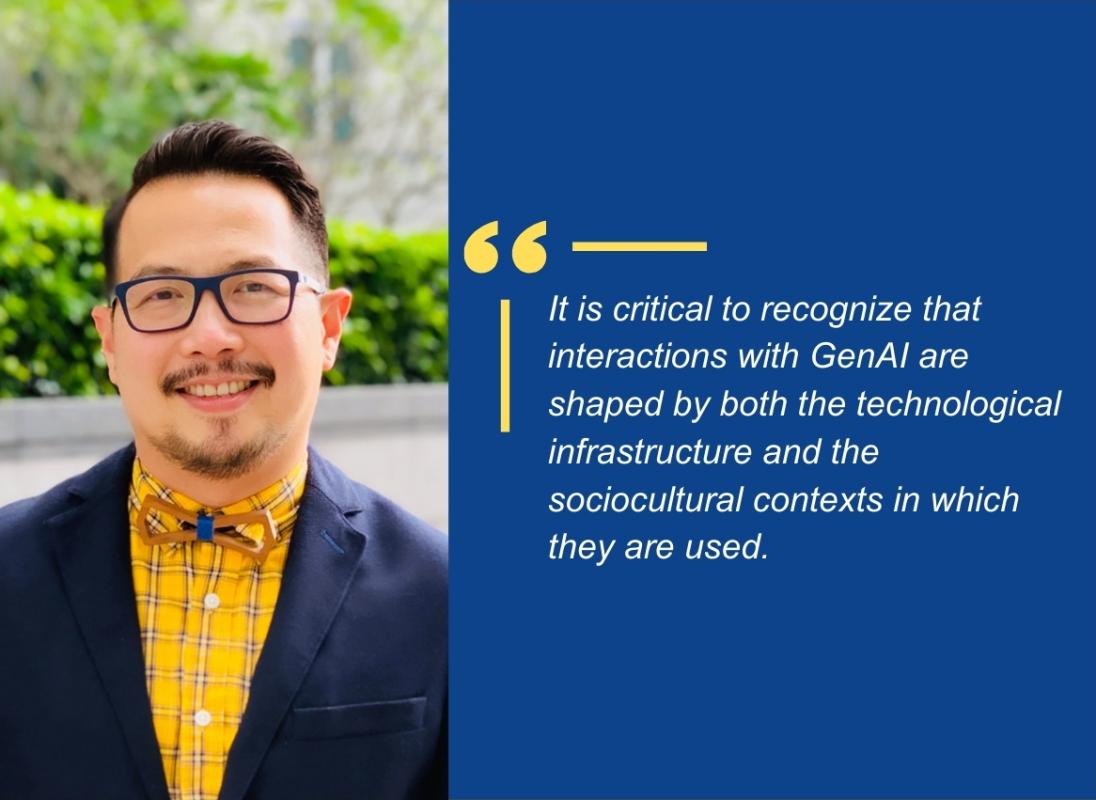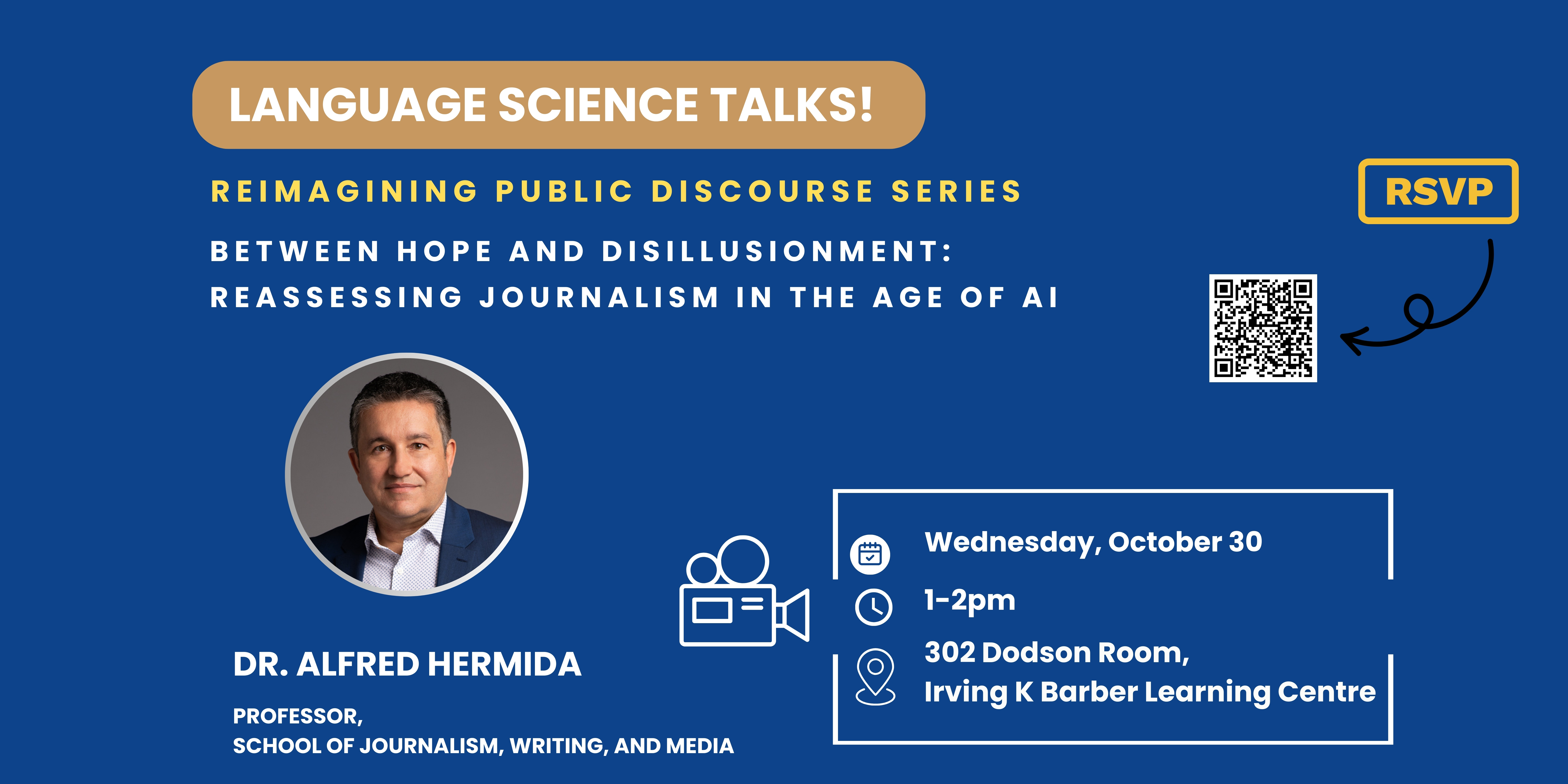The new LangSci Meets AI series features members' research on AI's development in their respective fields. Together, these conversations trace the contours of a landscape rapidly evolving, constantly rerouting our social fabrics. In this inaugural feature, we are glad to speak with Dr. Ron Darvin, LangSci's steering committee member who leads the "Reimagining Public Discourse" research area.
1.Tell us about your research interest(s) and how they are related to AI.
My primary research interest lies in understanding the impact of generative AI (GenAI) on the digital literacies of multilingual youth in Canada, particularly with regard to issues of equity and diversity. The phenomenal rise of GenAI technologies like ChatGPT is already transforming the foundations of how we learn, work, and interact with information. Earlier this year, OpenAI launched GPT-4o which they described as “omni-modal” because it’s able to reason swiftly across audio, vision, and text, making interactions more natural and fluid. Just last month, Apple announced the integration of Apple Intelligence into its latest iPhones, enabling automated writing and image generation features that will use personal data stored in these devices.
These innovations raise multiple questions about what it means to use these tools for learning, and it’s issues of plagiarism, inaccuracy and the violation of intellectual property rights that have been the most amplified concerns. What I’m particularly interested in however is to understand how the designs of GenAI platforms encourage different kinds of interactions between humans and tools, and how these differences can shape the kinds of information people get. There are also inequalities between free and premium versions of the same platform, and as learners access these platforms using a phone or a laptop, and employ different languages. Operating through large language models, GenAI technologies rely on linguistic data online, and in the economy of big data, there are data poor populations that have limited digital presence. Some languages have more data available than others, shaping the presence of high-resource and low-resource languages, and this inequality has implications in terms of the way multilingual learners engage with these technologies, and the diversity of the information they are able to access.
2. Let's focus on AI and learning. From your research, what are opportunities and challenges for language learning that GenAI offers?
GenAI has multiple affordances for language learning, and at the same time, certain constraints and potential pitfalls. On the one hand, its affordances include the capacity for real-time translation, generating varied linguistic outputs, and providing multimodal support (text, audio, and visual). This can empower multilingual learners to engage in language practices that are fluid and dynamic, offering customized learning experiences that enable them to draw on their multimodal resources. ChatGPT can serve as a conversation partner that can move across languages and provide feedback on one’s writing. Hume’s ability to detect emotional cues in spoken language could help learners to engage in role-playing and simulations where emotional expression is key and to pay attention to rhythm, stress and intonation patterns.
While there are various affordances for language learning, there are also significant constraints. The linguistic output of GenAI may seem very human-like, but these tools really function as stochastic parrots. They string words together based on statistical probabilities, and their responses aren’t always accurate. Because of the inequalities of high-resource and low-resource languages, learners from different linguistic backgrounds may experience unequal access to knowledge and support. In my research with multilingual secondary school students in BC, I’ve seen how ChatGPT couldn’t recognize learners’ spoken prompts in Malayalam and Hazaragi, churning out inaccurate responses and replying in cognate languages. As these tools make certain decisions about grammaticality and the way a text should be revised, they can reproduce ideologies of nativespeakerism. While GenAI platforms can respond in diverse languages, these technologies operate through a black box, and we do not know to what extent generated answers represent a diversity of ideas. How these tools contribute to the homogenization of knowledge and the reproduction of colonial ways of thinking is something that needs to be investigated further.
3. Natural language processing and large language models are developing at an unprecedented speed. Do you think teachers and learners in Canada are equipped with the necessary digital literacies to navigate this evolving landscape? What are the implications of this?
Surveys have shown that in Canada, more than half of students have used GenAI for their schoolwork, but UNESCO has reported that globally, fewer than 10% of schools and universities have developed policies or formal guidance regarding the use of these tools. In the Pro-D workshops on GenAI that I’ve done for schools here in BC, teachers have shown great interest in understanding the pedagogical possibilities that GenAI can offer and the digital literacies necessary to use these tools agentively and critically. These technologies however are still very new and are evolving quite rapidly, and there is a need to articulate further what constitutes functional and critical digital literacies. What should teachers and learners pay attention to? How can they not only construct effective prompts, but also evaluate generated responses, and detect biases and assumptions? These are questions that my current research seeks to address.
4. What can be done to facilitate effective learning with GenAI?
To facilitate effective learning with GenAI, we need a multifaceted approach. First, it’s important to develop digital literacy frameworks that recognize the sociocultural and material dimensions of learning, rather than view digital literacy as merely a set of skills. This includes educating learners on the way these tools work and how underlying algorithmic and data biases can produce unreliable answers. Additionally, there is a need for educational policies that not only spell out what students can or cannot do with these tools but also promote equitable access to digital resources and consider the unique needs of multilingual learners, ensuring that low-resource languages and their speakers are not marginalized by GenAI systems.
5. Is there anything else you’d like to say regarding these issues?
It is critical to recognize that interactions with GenAI are shaped by both the technological infrastructure and the sociocultural contexts in which they are used. Given that individual learners use GenAI platforms in often private and isolated contexts, and receive distinctive answers even for the same question, there is a need for research that enables a detailed examination of these interactions. Such research would facilitate the comparison of diverse patterns of use and the range of responses generated for individual users. It is through the particularization that various case studies can offer that researchers can gain an understanding of the inequalities of use that are concealed by the black box of AI.

